Project Management: Calculations of PERT and CPM, Change Management, and Requirement Gathering
VerifiedAdded on 2022/11/25
|9
|1335
|181
AI Summary
This report states the calculations of PERT and CPM for a particular project. This project also defines the different definitions of project management along with change management in project. Different techniques of project management are also explained in this project along with the different tools that are used for requirement gathering in a project.
Contribute Materials
Your contribution can guide someone’s learning journey. Share your
documents today.
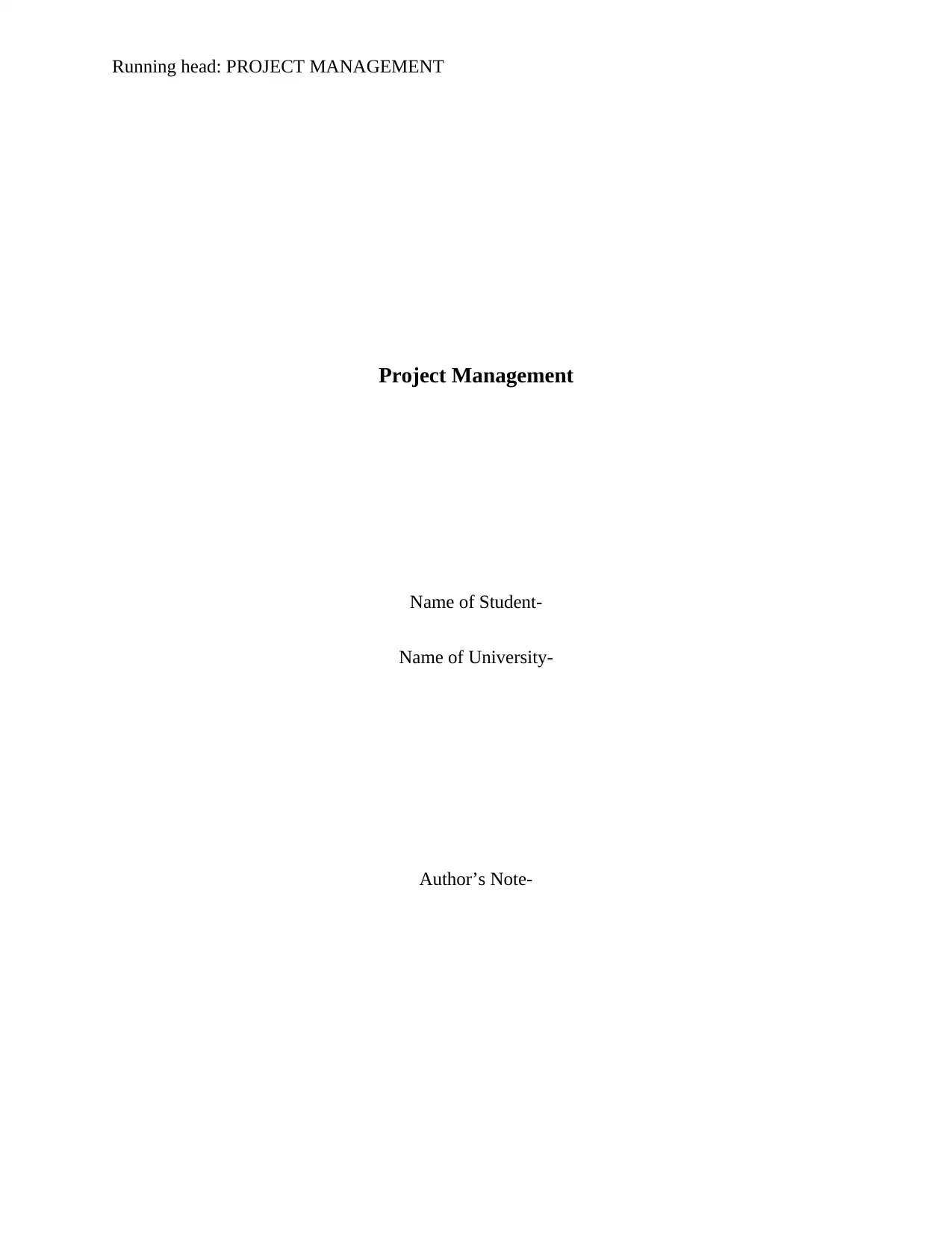
Running head: PROJECT MANAGEMENT
Project Management
Name of Student-
Name of University-
Author’s Note-
Project Management
Name of Student-
Name of University-
Author’s Note-
Secure Best Marks with AI Grader
Need help grading? Try our AI Grader for instant feedback on your assignments.
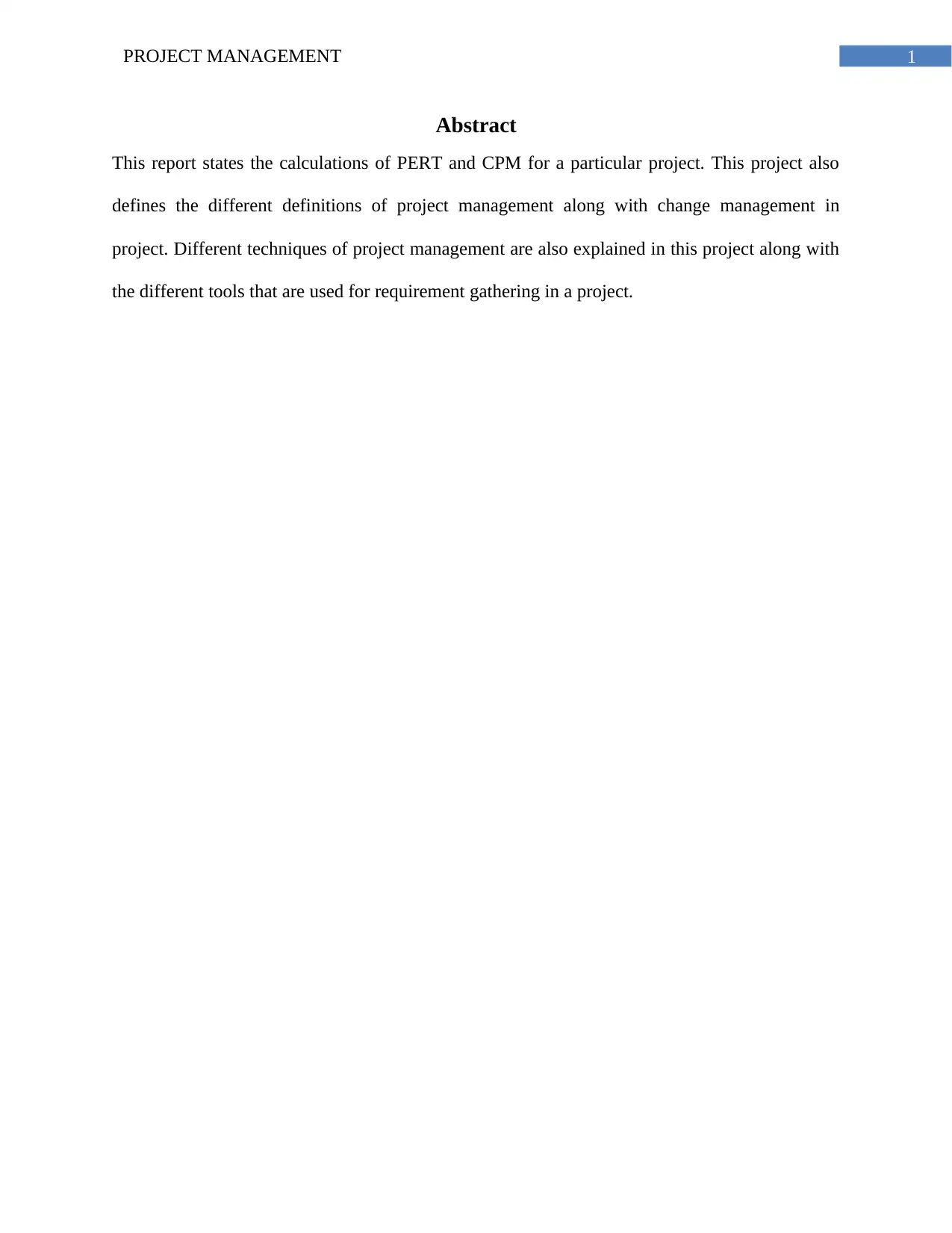
1PROJECT MANAGEMENT
Abstract
This report states the calculations of PERT and CPM for a particular project. This project also
defines the different definitions of project management along with change management in
project. Different techniques of project management are also explained in this project along with
the different tools that are used for requirement gathering in a project.
Abstract
This report states the calculations of PERT and CPM for a particular project. This project also
defines the different definitions of project management along with change management in
project. Different techniques of project management are also explained in this project along with
the different tools that are used for requirement gathering in a project.
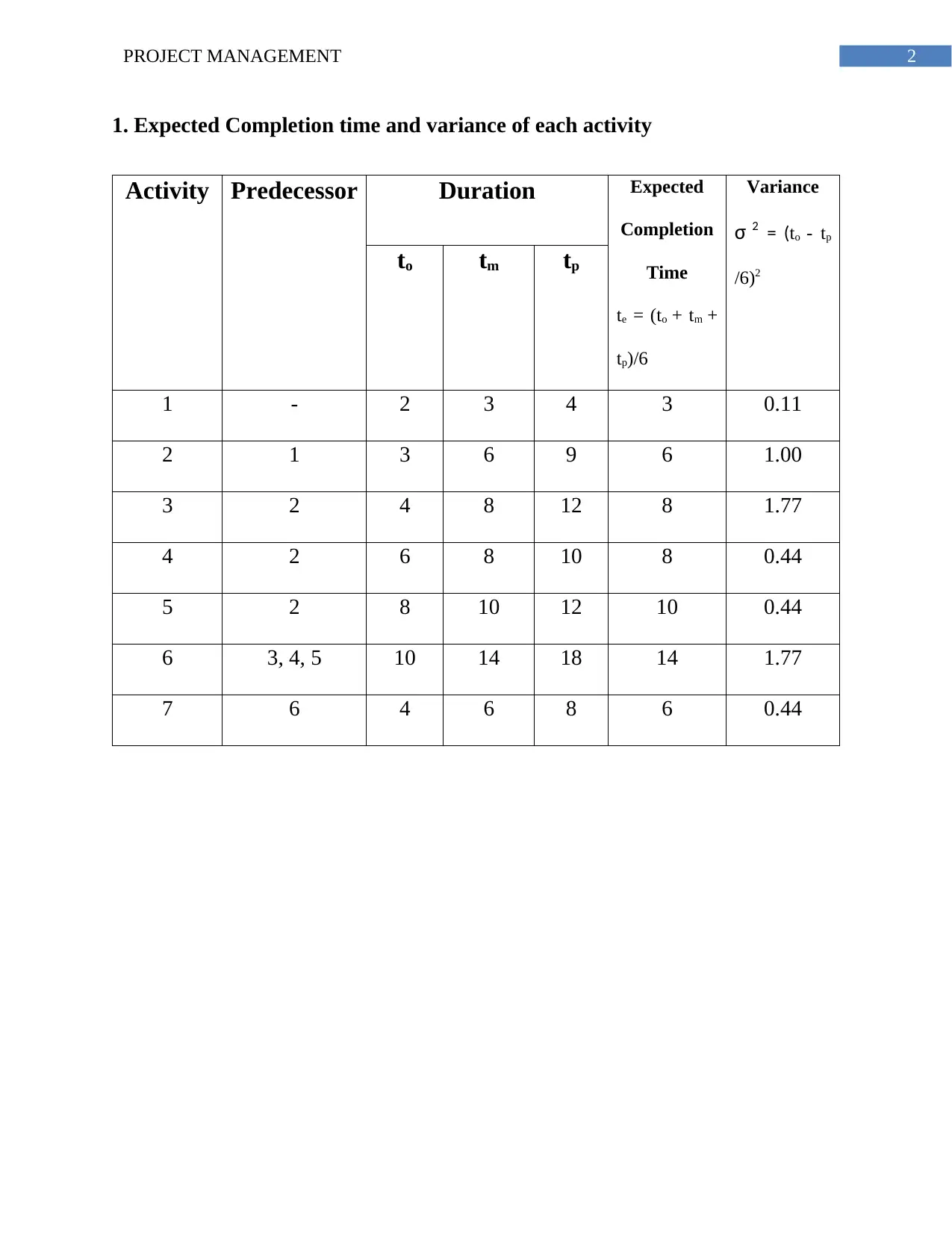
2PROJECT MANAGEMENT
1. Expected Completion time and variance of each activity
Activity Predecessor Duration Expected
Completion
Time
te = (to + tm +
tp)/6
Variance
σ 2 = (to - tp
/6)2
to tm tp
1 - 2 3 4 3 0.11
2 1 3 6 9 6 1.00
3 2 4 8 12 8 1.77
4 2 6 8 10 8 0.44
5 2 8 10 12 10 0.44
6 3, 4, 5 10 14 18 14 1.77
7 6 4 6 8 6 0.44
1. Expected Completion time and variance of each activity
Activity Predecessor Duration Expected
Completion
Time
te = (to + tm +
tp)/6
Variance
σ 2 = (to - tp
/6)2
to tm tp
1 - 2 3 4 3 0.11
2 1 3 6 9 6 1.00
3 2 4 8 12 8 1.77
4 2 6 8 10 8 0.44
5 2 8 10 12 10 0.44
6 3, 4, 5 10 14 18 14 1.77
7 6 4 6 8 6 0.44
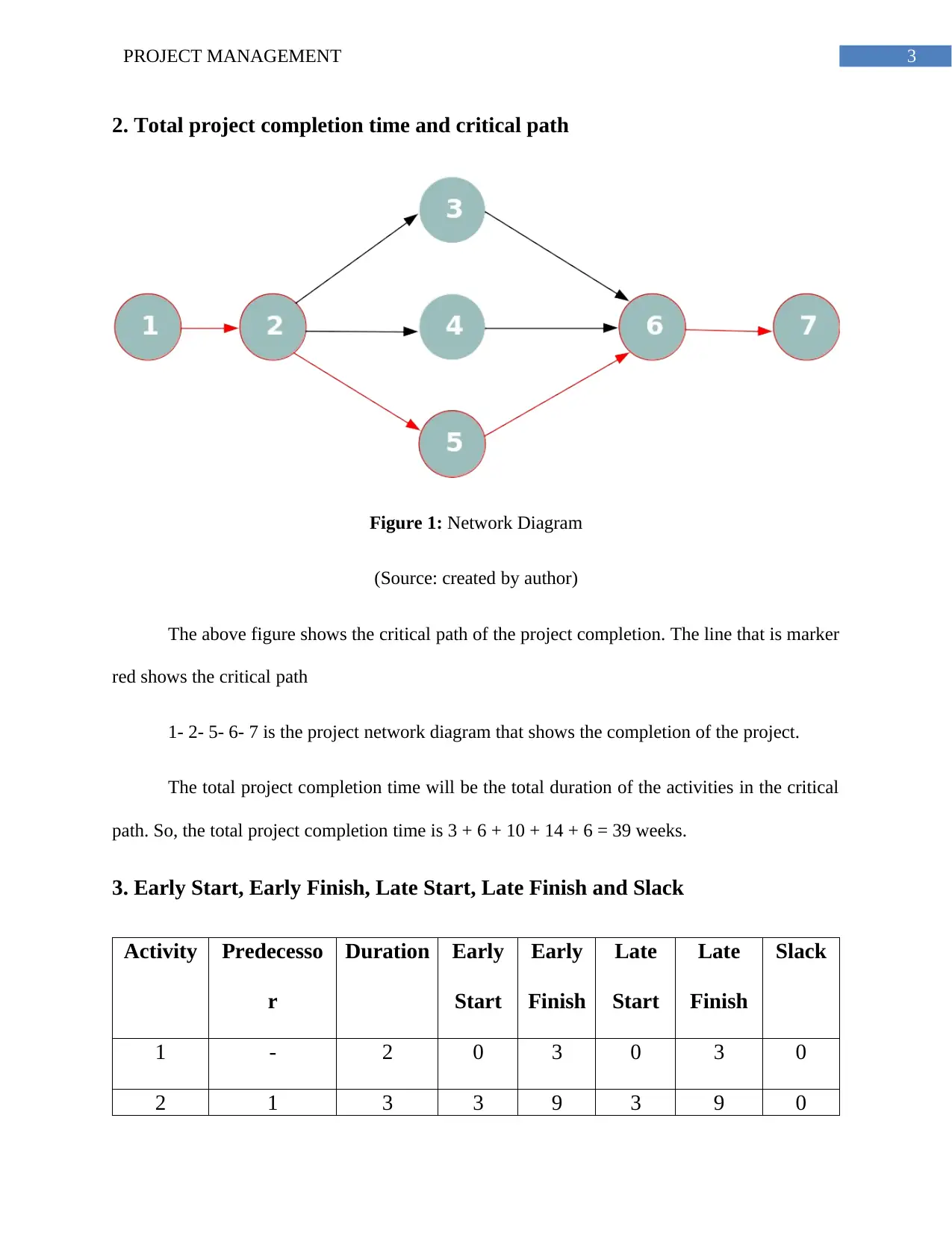
3PROJECT MANAGEMENT
2. Total project completion time and critical path
Figure 1: Network Diagram
(Source: created by author)
The above figure shows the critical path of the project completion. The line that is marker
red shows the critical path
1- 2- 5- 6- 7 is the project network diagram that shows the completion of the project.
The total project completion time will be the total duration of the activities in the critical
path. So, the total project completion time is 3 + 6 + 10 + 14 + 6 = 39 weeks.
3. Early Start, Early Finish, Late Start, Late Finish and Slack
Activity Predecesso
r
Duration Early
Start
Early
Finish
Late
Start
Late
Finish
Slack
1 - 2 0 3 0 3 0
2 1 3 3 9 3 9 0
2. Total project completion time and critical path
Figure 1: Network Diagram
(Source: created by author)
The above figure shows the critical path of the project completion. The line that is marker
red shows the critical path
1- 2- 5- 6- 7 is the project network diagram that shows the completion of the project.
The total project completion time will be the total duration of the activities in the critical
path. So, the total project completion time is 3 + 6 + 10 + 14 + 6 = 39 weeks.
3. Early Start, Early Finish, Late Start, Late Finish and Slack
Activity Predecesso
r
Duration Early
Start
Early
Finish
Late
Start
Late
Finish
Slack
1 - 2 0 3 0 3 0
2 1 3 3 9 3 9 0
Secure Best Marks with AI Grader
Need help grading? Try our AI Grader for instant feedback on your assignments.
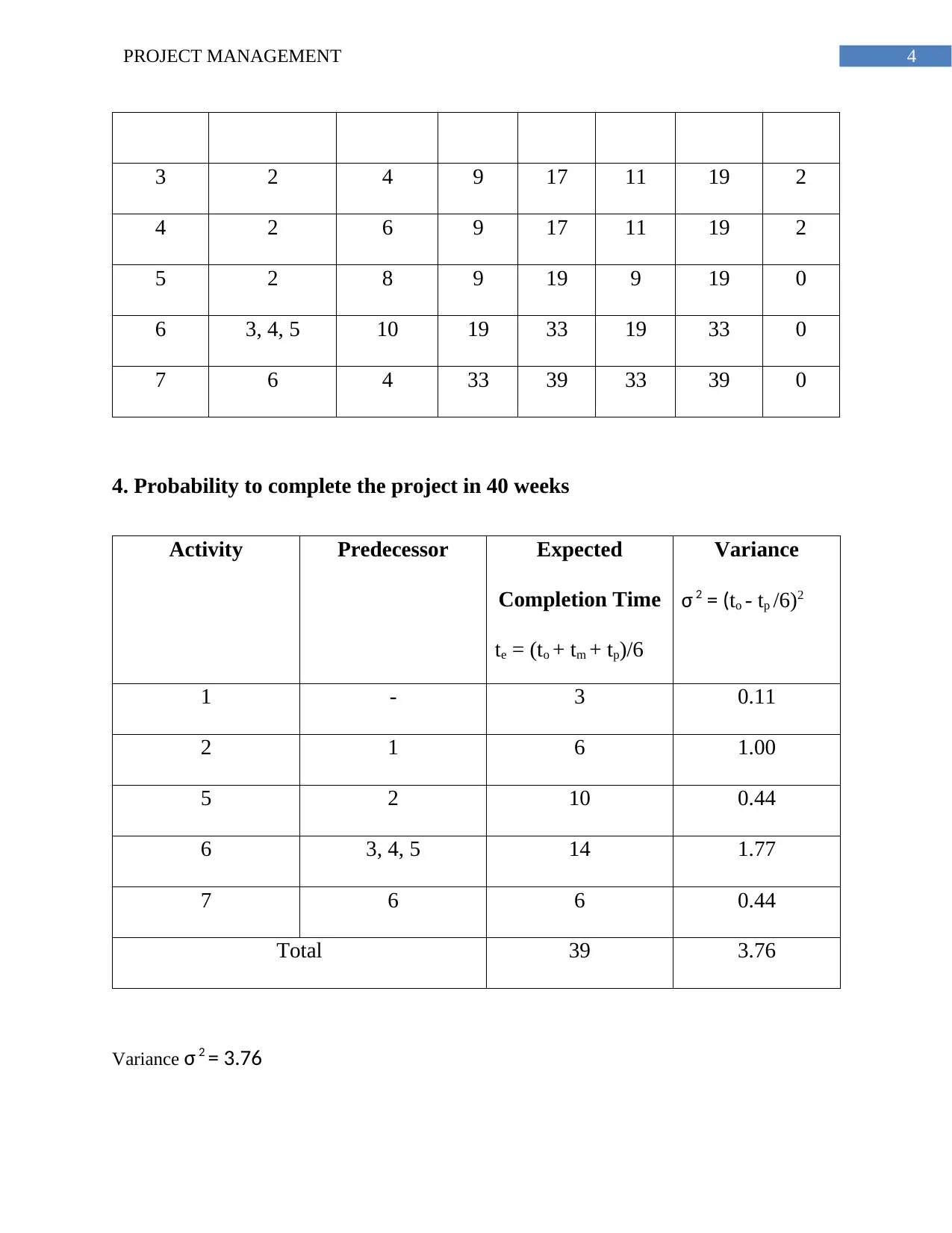
4PROJECT MANAGEMENT
3 2 4 9 17 11 19 2
4 2 6 9 17 11 19 2
5 2 8 9 19 9 19 0
6 3, 4, 5 10 19 33 19 33 0
7 6 4 33 39 33 39 0
4. Probability to complete the project in 40 weeks
Activity Predecessor Expected
Completion Time
te = (to + tm + tp)/6
Variance
σ 2 = (to - tp /6)2
1 - 3 0.11
2 1 6 1.00
5 2 10 0.44
6 3, 4, 5 14 1.77
7 6 6 0.44
Total 39 3.76
Variance σ 2 = 3.76
3 2 4 9 17 11 19 2
4 2 6 9 17 11 19 2
5 2 8 9 19 9 19 0
6 3, 4, 5 10 19 33 19 33 0
7 6 4 33 39 33 39 0
4. Probability to complete the project in 40 weeks
Activity Predecessor Expected
Completion Time
te = (to + tm + tp)/6
Variance
σ 2 = (to - tp /6)2
1 - 3 0.11
2 1 6 1.00
5 2 10 0.44
6 3, 4, 5 14 1.77
7 6 6 0.44
Total 39 3.76
Variance σ 2 = 3.76
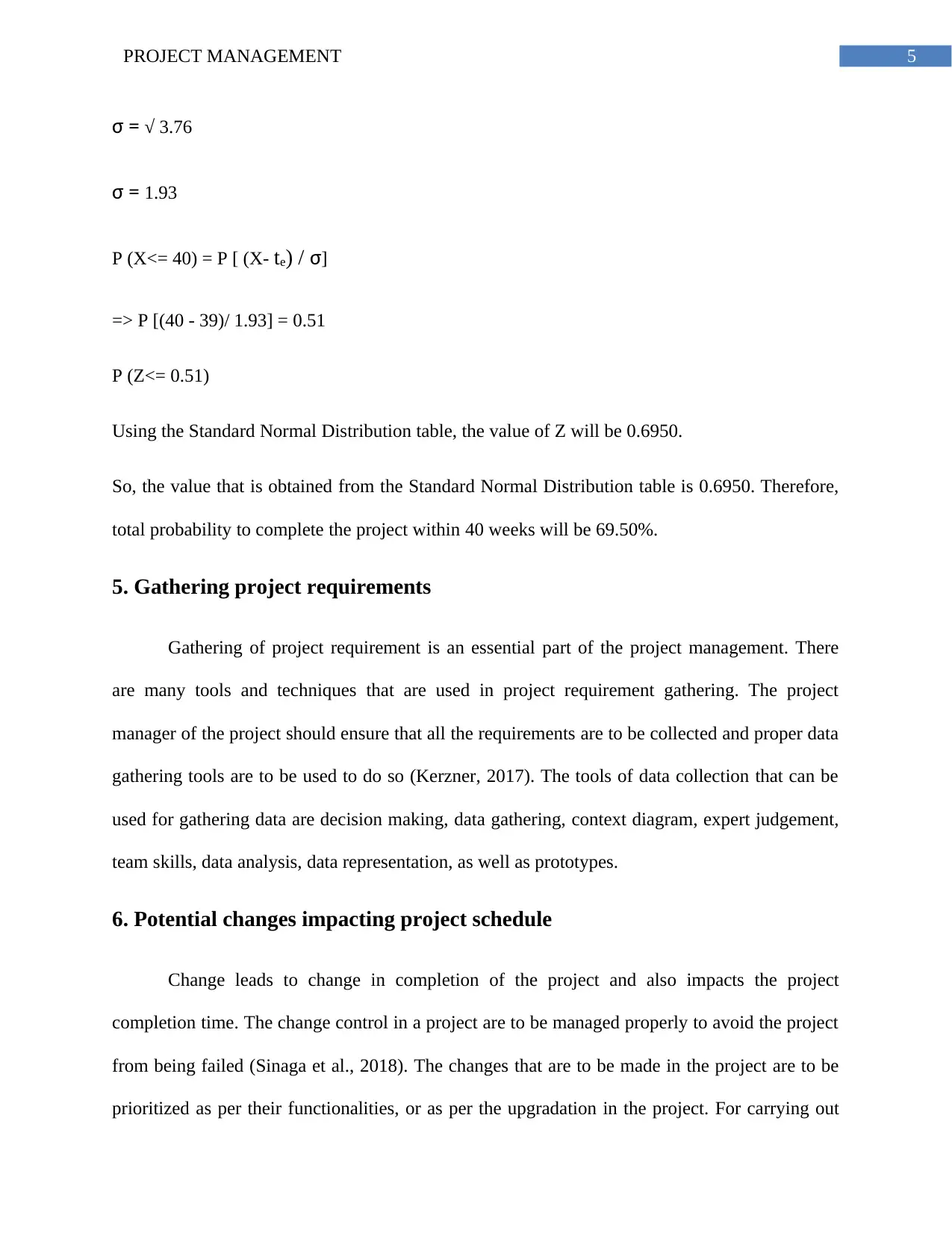
5PROJECT MANAGEMENT
σ = √ 3.76
σ = 1.93
P (X<= 40) = P [ (X- te) / σ]
=> P [(40 - 39)/ 1.93] = 0.51
P (Z<= 0.51)
Using the Standard Normal Distribution table, the value of Z will be 0.6950.
So, the value that is obtained from the Standard Normal Distribution table is 0.6950. Therefore,
total probability to complete the project within 40 weeks will be 69.50%.
5. Gathering project requirements
Gathering of project requirement is an essential part of the project management. There
are many tools and techniques that are used in project requirement gathering. The project
manager of the project should ensure that all the requirements are to be collected and proper data
gathering tools are to be used to do so (Kerzner, 2017). The tools of data collection that can be
used for gathering data are decision making, data gathering, context diagram, expert judgement,
team skills, data analysis, data representation, as well as prototypes.
6. Potential changes impacting project schedule
Change leads to change in completion of the project and also impacts the project
completion time. The change control in a project are to be managed properly to avoid the project
from being failed (Sinaga et al., 2018). The changes that are to be made in the project are to be
prioritized as per their functionalities, or as per the upgradation in the project. For carrying out
σ = √ 3.76
σ = 1.93
P (X<= 40) = P [ (X- te) / σ]
=> P [(40 - 39)/ 1.93] = 0.51
P (Z<= 0.51)
Using the Standard Normal Distribution table, the value of Z will be 0.6950.
So, the value that is obtained from the Standard Normal Distribution table is 0.6950. Therefore,
total probability to complete the project within 40 weeks will be 69.50%.
5. Gathering project requirements
Gathering of project requirement is an essential part of the project management. There
are many tools and techniques that are used in project requirement gathering. The project
manager of the project should ensure that all the requirements are to be collected and proper data
gathering tools are to be used to do so (Kerzner, 2017). The tools of data collection that can be
used for gathering data are decision making, data gathering, context diagram, expert judgement,
team skills, data analysis, data representation, as well as prototypes.
6. Potential changes impacting project schedule
Change leads to change in completion of the project and also impacts the project
completion time. The change control in a project are to be managed properly to avoid the project
from being failed (Sinaga et al., 2018). The changes that are to be made in the project are to be
prioritized as per their functionalities, or as per the upgradation in the project. For carrying out
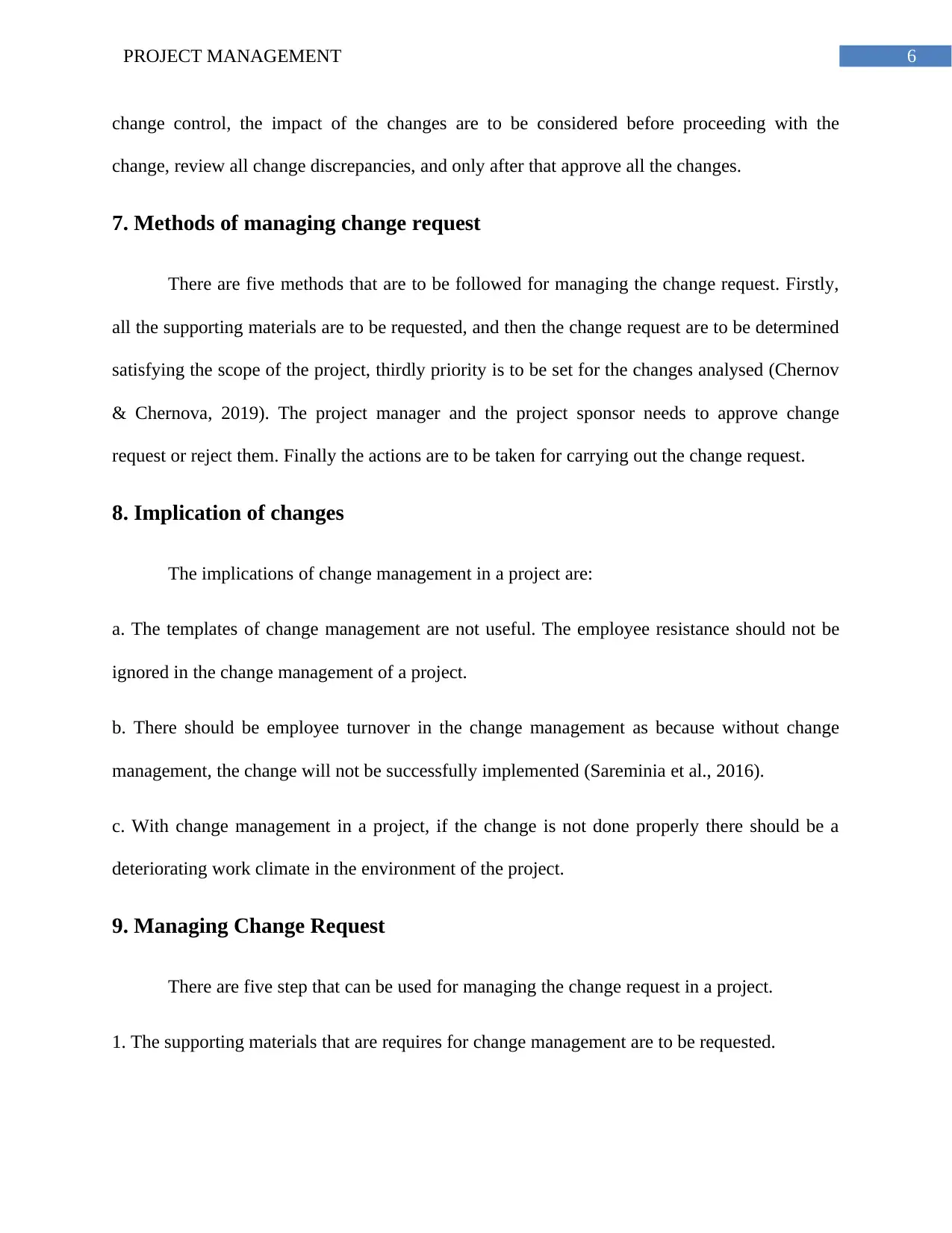
6PROJECT MANAGEMENT
change control, the impact of the changes are to be considered before proceeding with the
change, review all change discrepancies, and only after that approve all the changes.
7. Methods of managing change request
There are five methods that are to be followed for managing the change request. Firstly,
all the supporting materials are to be requested, and then the change request are to be determined
satisfying the scope of the project, thirdly priority is to be set for the changes analysed (Chernov
& Chernova, 2019). The project manager and the project sponsor needs to approve change
request or reject them. Finally the actions are to be taken for carrying out the change request.
8. Implication of changes
The implications of change management in a project are:
a. The templates of change management are not useful. The employee resistance should not be
ignored in the change management of a project.
b. There should be employee turnover in the change management as because without change
management, the change will not be successfully implemented (Sareminia et al., 2016).
c. With change management in a project, if the change is not done properly there should be a
deteriorating work climate in the environment of the project.
9. Managing Change Request
There are five step that can be used for managing the change request in a project.
1. The supporting materials that are requires for change management are to be requested.
change control, the impact of the changes are to be considered before proceeding with the
change, review all change discrepancies, and only after that approve all the changes.
7. Methods of managing change request
There are five methods that are to be followed for managing the change request. Firstly,
all the supporting materials are to be requested, and then the change request are to be determined
satisfying the scope of the project, thirdly priority is to be set for the changes analysed (Chernov
& Chernova, 2019). The project manager and the project sponsor needs to approve change
request or reject them. Finally the actions are to be taken for carrying out the change request.
8. Implication of changes
The implications of change management in a project are:
a. The templates of change management are not useful. The employee resistance should not be
ignored in the change management of a project.
b. There should be employee turnover in the change management as because without change
management, the change will not be successfully implemented (Sareminia et al., 2016).
c. With change management in a project, if the change is not done properly there should be a
deteriorating work climate in the environment of the project.
9. Managing Change Request
There are five step that can be used for managing the change request in a project.
1. The supporting materials that are requires for change management are to be requested.
Paraphrase This Document
Need a fresh take? Get an instant paraphrase of this document with our AI Paraphraser
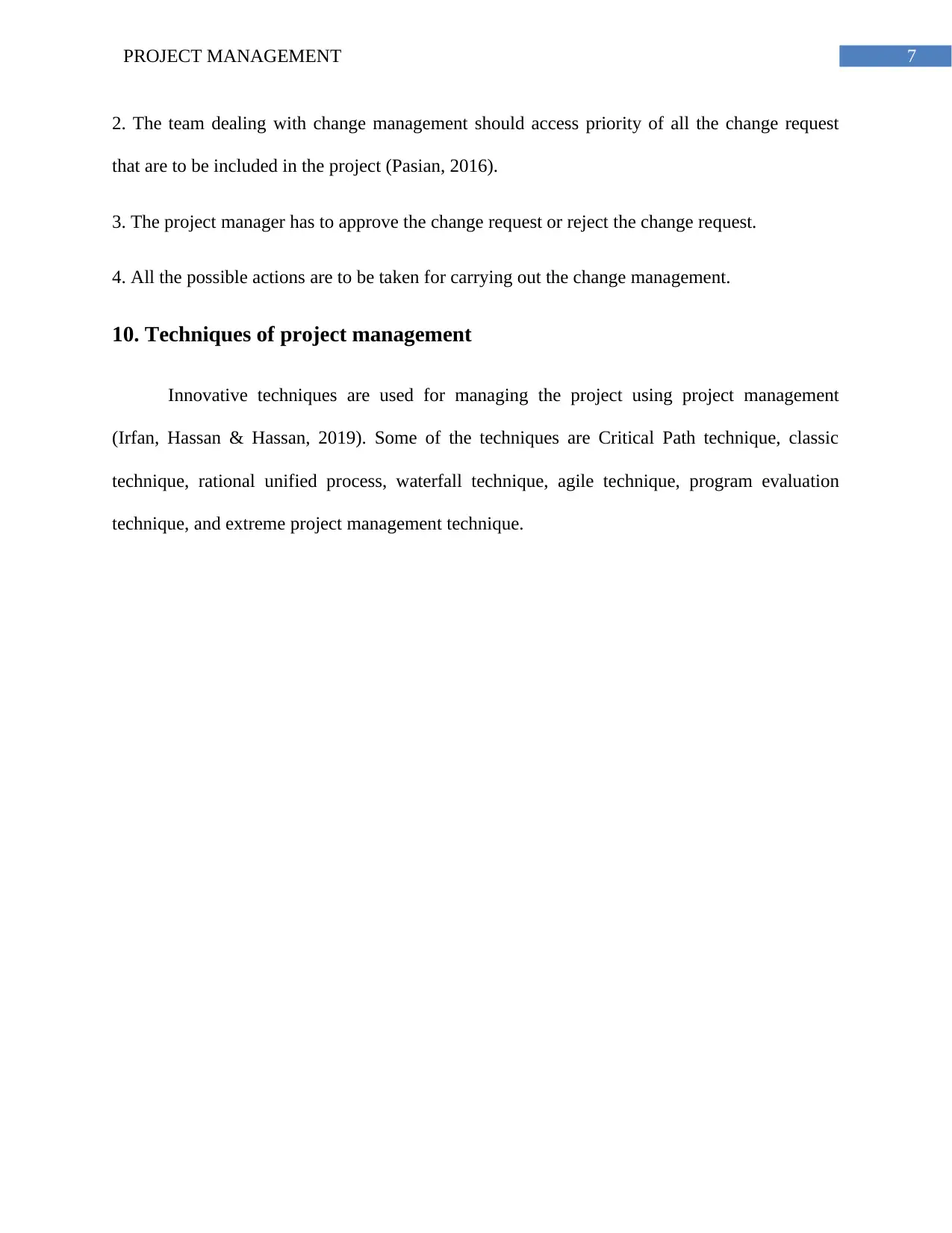
7PROJECT MANAGEMENT
2. The team dealing with change management should access priority of all the change request
that are to be included in the project (Pasian, 2016).
3. The project manager has to approve the change request or reject the change request.
4. All the possible actions are to be taken for carrying out the change management.
10. Techniques of project management
Innovative techniques are used for managing the project using project management
(Irfan, Hassan & Hassan, 2019). Some of the techniques are Critical Path technique, classic
technique, rational unified process, waterfall technique, agile technique, program evaluation
technique, and extreme project management technique.
2. The team dealing with change management should access priority of all the change request
that are to be included in the project (Pasian, 2016).
3. The project manager has to approve the change request or reject the change request.
4. All the possible actions are to be taken for carrying out the change management.
10. Techniques of project management
Innovative techniques are used for managing the project using project management
(Irfan, Hassan & Hassan, 2019). Some of the techniques are Critical Path technique, classic
technique, rational unified process, waterfall technique, agile technique, program evaluation
technique, and extreme project management technique.
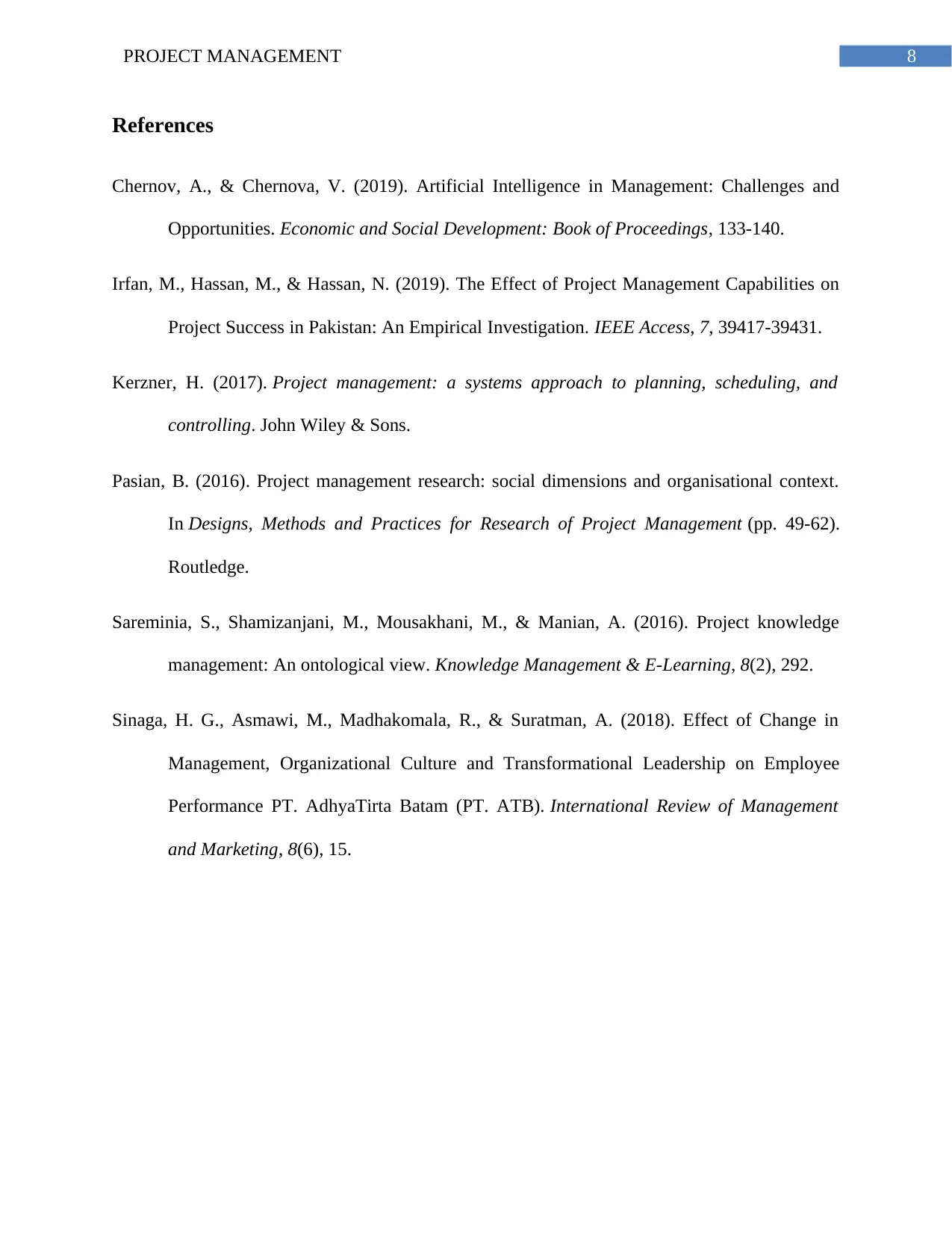
8PROJECT MANAGEMENT
References
Chernov, A., & Chernova, V. (2019). Artificial Intelligence in Management: Challenges and
Opportunities. Economic and Social Development: Book of Proceedings, 133-140.
Irfan, M., Hassan, M., & Hassan, N. (2019). The Effect of Project Management Capabilities on
Project Success in Pakistan: An Empirical Investigation. IEEE Access, 7, 39417-39431.
Kerzner, H. (2017). Project management: a systems approach to planning, scheduling, and
controlling. John Wiley & Sons.
Pasian, B. (2016). Project management research: social dimensions and organisational context.
In Designs, Methods and Practices for Research of Project Management (pp. 49-62).
Routledge.
Sareminia, S., Shamizanjani, M., Mousakhani, M., & Manian, A. (2016). Project knowledge
management: An ontological view. Knowledge Management & E-Learning, 8(2), 292.
Sinaga, H. G., Asmawi, M., Madhakomala, R., & Suratman, A. (2018). Effect of Change in
Management, Organizational Culture and Transformational Leadership on Employee
Performance PT. AdhyaTirta Batam (PT. ATB). International Review of Management
and Marketing, 8(6), 15.
References
Chernov, A., & Chernova, V. (2019). Artificial Intelligence in Management: Challenges and
Opportunities. Economic and Social Development: Book of Proceedings, 133-140.
Irfan, M., Hassan, M., & Hassan, N. (2019). The Effect of Project Management Capabilities on
Project Success in Pakistan: An Empirical Investigation. IEEE Access, 7, 39417-39431.
Kerzner, H. (2017). Project management: a systems approach to planning, scheduling, and
controlling. John Wiley & Sons.
Pasian, B. (2016). Project management research: social dimensions and organisational context.
In Designs, Methods and Practices for Research of Project Management (pp. 49-62).
Routledge.
Sareminia, S., Shamizanjani, M., Mousakhani, M., & Manian, A. (2016). Project knowledge
management: An ontological view. Knowledge Management & E-Learning, 8(2), 292.
Sinaga, H. G., Asmawi, M., Madhakomala, R., & Suratman, A. (2018). Effect of Change in
Management, Organizational Culture and Transformational Leadership on Employee
Performance PT. AdhyaTirta Batam (PT. ATB). International Review of Management
and Marketing, 8(6), 15.
1 out of 9
Related Documents
Your All-in-One AI-Powered Toolkit for Academic Success.
+13062052269
info@desklib.com
Available 24*7 on WhatsApp / Email
![[object Object]](/_next/static/media/star-bottom.7253800d.svg)
Unlock your academic potential
© 2024 | Zucol Services PVT LTD | All rights reserved.





